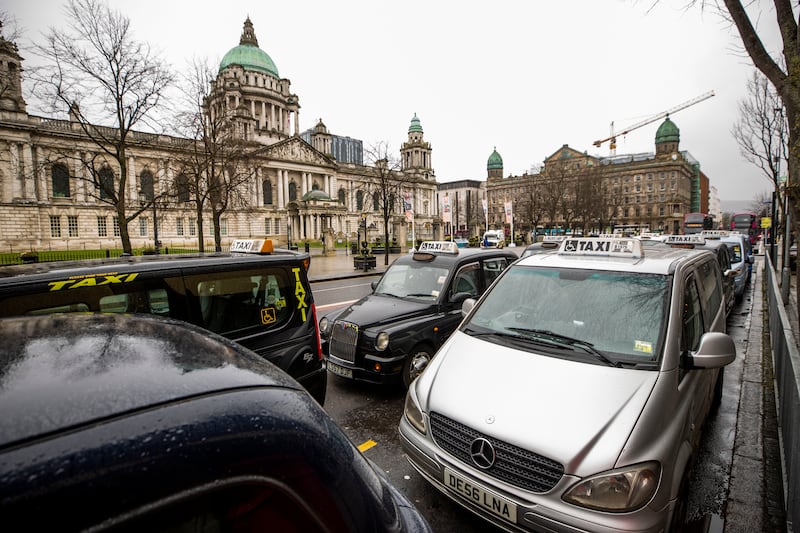Congestion has been acute in Belfast in recent weeks, mainly due to roadworks and a key train line closure. Generally, at peak times the city grinds to a standstill mainly because of our overdependence on private cars. This is unsurprising given there are four times as many cars today compared to the 1970s. Just before the train line reopened on October 13, the infrastructure minister John O’Dowd announced plans to allow all taxis to use bus lanes around the new Grand Central Station.
According to his department’s press release, this aims to alleviate some of the congestion around the public realm works which will continue into 2025. The minister described this as “experimental” and a pilot – the implication being that he intends to allow all taxis to access bus lanes. He added that this is to “support the taxi industry”, but what about supporting sustainable transport and the most vulnerable road users i.e. cyclists who use bus lanes?
There is an understandable perception that bus lanes are often empty, but this is how they are meant to function, ensuring buses can continually move so they are punctual. Buses are the most efficient use of road space, with the capacity to carry 80 passengers (or 105 for Glider), unlike cars which are the least.
Add more vehicles to bus lanes and they won’t be moving either. When Glider was introduced in Belfast, it saw a 70% increase in passengers in its first year, but it is dependent on the bus lane corridors to ensure a regular service.
In the absence of a cycling network in the city, bus lanes currently provide a relatively safe environment for cyclists and the Belfast Bike Share Scheme.
So why is it a bigger risk for cyclists to share bus lanes with taxis?

Most bus lanes in Belfast are 3 metres wide. A cyclist in a lane should be one metre or an arm’s length from the kerb edge to ensure a safe, visible position to other users. With the Highway Code and PSNI recommending a safe passing distance of 1.5m, there is no space for either buses or taxis to overtake.
The relationship between bus drivers and cyclists, while not perfect, has benefited from cyclist awareness training for Metro and Glider drivers.
Unlike buses, which are continually stopping to pick up passengers, taxis are motivated by getting to the next fare fast, and so our concern is that taxis will try to squeeze past cyclists, resulting in collisions.
This is not imaginary – taxis in bus lanes are considered the biggest problem for cycling safety in Dublin. On hearing O’Dowd’s announcement, the Dublin Commuter Coalition posted on X: “Crossing the border to shout ‘Nooooo, don’t make the mistake we did’ like some sort of time traveller from a dystopian future.”
Crossing the border to shout "nooooo, don't make the mistake we did" like some sort of time traveller from a dystopian future.https://t.co/T9XnK6gknn
— Dublin Commuters (@DublinCommuters) October 11, 2024
The Belfast Walking and Cycling Index 2023 shows there are 9,100 return trips by cyclists daily in Belfast by people who could have driven. If people no longer feel safe to cycle in bus lanes they will go back to driving and add to congestion.
If you let all taxis use bus lanes, why not the ordinary motorist or private delivery vehicle?
A small proportion of taxis are already allowed in bus lanes – taxi buses which provide for car-sharing of multiple passengers and Wheelchair Accessible Vehicles. By opening bus lanes to all taxis, this will greatly increase the numbers and result in congestion – the very issue the minister is trying to tackle.
Congestion could be tackled by better enforcement of urban clearways, yellow box junctions and extending the bus lane network, not compromising it
The Department for Infrastructure commissioned a study in Belfast in 2016 which found that taxis in bus lanes “could impede other road users and could increase bus journey times”.
We need to keep bus lanes for sustainable modes of transport to continue to attract people out of their polluting cars and not give special privileges to those who can afford a taxi.

Congestion could be tackled by better enforcement of urban clearways, yellow box junctions and extending the bus lane network, not compromising it.
We also expect increased investment in active travel through the Climate Change Act will finally see the birth of a proper protected cycling network in the city and elsewhere.
Anne Madden is policy and communications manager at Sustrans









